Executive Summary
Search Engine Optimization, or SEO, is the practice of trying to maximizing how often a website comes up at the top of search engine results for various keywords, increasing the number of website users to visit a particular website (i.e., website traffic), and ideally bringing visitors who are part of an appropriately targeted audience (and thus are likely to find value in the website and decide to do business). Which is a valuable marketing strategy for financial advisors to make themselves “findable” for consumers who are seeking out a financial advisor to work with (or more generally, someone who can help them with whatever financial problems they’re searching online for answers to!).
In this guest post, Lee Delahoussaye – Founder and Chief Consultant of Mindtap Marketing, a digital marketing consulting firm – provides an overview of how SEO works and discusses how financial advisors can implement simple SEO techniques to optimize their websites for better search rankings.
While there are many different approaches to developing an SEO strategy, the key ingredient that makes SEO work is understanding intent. Unlike other forms of advertising that are based on putting messages in front of people who might be interested in an advisor’s services, internet searchers oftentimes have a specific intention to find something in particular, whether that be a service, product, or getting more information and education. Which is important, because people with a direct need for financial advice search by the tens-of-thousands, with nearly 30,000 searches for terms related to “financial advisor near me” per month. And because the financial services industry is way behind the curve on this, there are still opportunities to achieve positive SEO results by leveraging the intent of those potential clients to find you as their new financial advisor, and ultimately channeling those clients to seek your advisory services.
Importantly, though, designing effective SEO strategies requires a basic understanding of how search engines actually work. And while search algorithms are highly-guarded intellectual property, it is possible to reverse engineer what limited information is known about those algorithms in order to determine a set of repeatable best practices, and then apply those best practices to improve a financial advisor’s search rankings. A good SEO design will start with identifying appropriate keywords or key phrases that the ideal visitor would likely search for and then including those keywords on the website, as well as developing website content to align with the context around those keywords.
There are four basic types of SEO on which specific strategies are based. These include on-page SEO (which encompasses the things that are done on a web page to improve rankings), off-page SEO (which is all about building external links from outside websites to yours), national/international SEO (geared to appeal to audiences based across broad geographic areas), and local SEO (which focuses on an immediate area such as a city, metropolitan area, or cluster of ZIP codes). Financial advisors can employ a mix of these SEO strategies to target visitors that are interested in their services, increasing their organic website traffic with potential clients by improving their search relevance.
Ultimately, the key point is that simple SEO techniques can be powerful tools for financial advisors to develop their own leads through “organic” internet searches. And while some advisors actually pay search engines directly to show up ahead of organic results (without actually attending to organic methods that would influence how their website would be inherently ranked and included in search results), implementing specific SEO strategies can optimize a website in order to attract a certain base of searchers more organically (and at a lower cost) that fit the advisory firm’s ideal target client and are seeking out the services of a financial advisor.
Search engine optimization (SEO) encompasses all of the things that can be done to get a web page to appear at or near the top of the results for a given search query, with the ultimate goal of increasing the number of website visitors to a particular site, as well as improving the quality of the visitors. Because unless a website appears among the top-ranking results of a search query, chances are that website will never even be visited since it will be buried in the thousands of other results that are listed.
Most advisors have probably heard of SEO, and some have a sense that they can benefit from it, but very few know where and how to start. Fortunately, there are several tools that can help advisors be confident to take advantage of the awesome opportunity SEO presents to them.
Why SEO Matters to Financial Advisors and Their Firms
Regardless of whether someone operates an advisory practice or a toy retailer, understanding the power of SEO starts with the concept of intent. Search marketing is unlike traditional advertising in that an advisor isn’t putting a message out there to catch the eye of someone who might (or might not) be interested in their services to discover – instead, they’re providing a solution for an intentionally sought and explicitly expressed need.
While search marketing doesn’t matter much to the people who aren’t asking questions that a financial advisor can answer, the data show that this is generally not a problem for financial advisors. The image below shows the number of searches in the US for the top ten terms related to “financial advisor near me,” every month, which in aggregate amounts to about 27,000 queries.
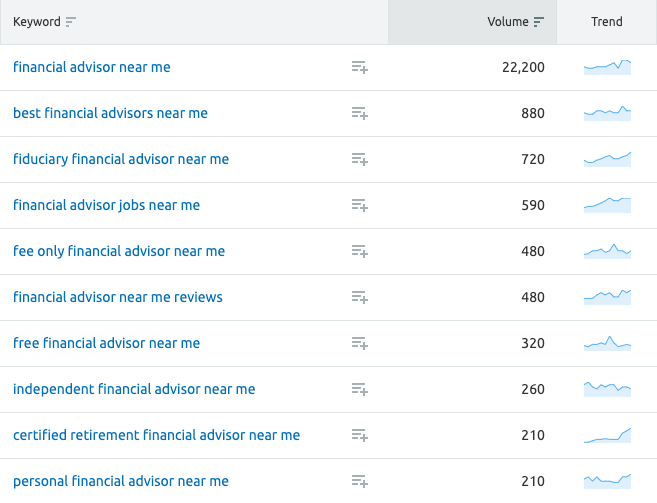
And that’s only a fraction of the volume, considering the hundreds of variants such as “financial planner near me” and “investment advisor near me”.
In addition to volume, the other key SEO metric to consider is how much competition there is to rank on the first page for a given search term. Put simply, the less competition there is, the less effort and expense is required to rank well. Importantly, for financial advisors, there’s very little competition for these terms because most other financial advisors don’t use SEO strategies at all – and that presents a big opportunity for the advisor who does decide to implement an SEO strategy to grow their client base.
But because financial advisors don’t typically specialize in SEO and know much about the technical machinations of website design, many of them have purchased leads from third-party services. These advisors often discover that they don’t like to call on leads that: 1) have no idea who they are, and 2) are being called on by their competitors at the same time.
For advisors who do take some time to work on some simple SEO strategies to generate their own leads, however, both issues are eliminated. A lead who finds an advisor by visiting their website expects to hear from that advisor and, in most cases, from only that advisor.
Fortunately, SEO isn’t that complicated. A basic understanding of just a few key concepts can help advisors understand the value of using SEO to generate their own leads, and to answer the question: “How in the world do I go about it?!”
How Financial Advisors Can Implement an Effective SEO Strategy
In order to understand how to ‘do’ SEO, it helps to first know a bit about why and how Google – and other search engines – do what they do.
Search engines’ core business is to return the most relevant, high-quality results for any given search. This is achieved by search algorithms. Google’s rise to prominence was mostly because their first algorithm – named “PageRank” after founder Larry Page – was better at returning quality results than Yahoo! or any of the other players.
Today, PageRank is still the primary algorithm, but others have been added over time; together they analyze over 200 data points in order to determine where a site ranks among its competitors.
SEO, then, is about understanding the criteria by which Google ranks pages and using strategies to satisfy those criteria. This can be tricky because:
- Google guards the structure and content of their algorithms like they’re nuclear codes. As a result, SEO practitioners make use of the occasional hints dropped on Google’s search blog, with lots of testing and reverse engineering.
- The algorithms are constantly evolving, so the most successful SEO efforts are ongoing. While the sites that are generally affected the most after algorithm updates are the ones engaging in what might be considered sketchy, “black hat” tactics (and we’re going to steer clear of those!), it is still important for all SEO designers to revisit the strategies employed to ensure their SEO results stay effective.
SEO revolves around a few overarching concepts that, once understood, will equip an advisor with the basic knowledge to comfortably work with a reputable agency or contractor without the fear of being scammed. These concepts can also provide “DIY” types with enough information to begin optimizing their own web presences with confidence.
Using Keywords and SEO Categories
All SEO revolves around the concept of “keywords” or “key phrases”, the words or phrases that searchers enter into the Google search box. And these are critical, because the ultimate aim is to match website content with words that people are most commonly using to search for information related to the service or product that is being provided through the website.
For example, someone wondering how the SECURE Act will impact their retirement savings might type “SECURE Act effect on retirement.” A blog post titled “Congress Proposes Legislation That Will Change How Americans Save” might not get ranked as highly as a different blog post titled “How the SECURE Act Would Impact Future Retirement Savings”
Or if someone is looking for a local financial advisor, they might type “best financial advisor near me.” If a nearby advisor doesn’t have the firm’s address on the website, that advisor’s business will likely be excluded from the search results.
Second in importance to keywords is how SEO practices are categorized. There are four main categories of SEO searches:
- “On-Page SEO” involves optimizing an individual website itself, so that it ranks more highly in particular search queries, which will generate relevant traffic coming to the site.
- “Off-Page SEO” involves strategies that promote a website to appear on other websites elsewhere on the web (e.g., by placing ads, or by being listed as a resource on another website).
- General “SEO”, broadly defined, refers to searches that target national or international audience.
- “Local SEO” is primarily used by local businesses who want to focus on a smaller geographical target audience.
These categories are not mutually exclusive – an SEO strategy can consist of one or more of these four types of searches, and all can have relevance to financial advisors seeking to target the right audiences and grow their firms.
On-Page SEO Search Strategies
A good on-page SEO strategy takes a little bit of planning but can go a long way to increase desirable traffic to a website. The process starts with identifying appropriate keywords to target, and then designing web elements that will attract traffic based on those specific target keywords (or updating elements of an already-existing website).
When considering keywords, two important criteria should be considered:
- Volume assesses which keywords are used the most, and is expressed by the estimated number of searches for a given search term per month; and
- Competition (or “keyword difficulty”) measures how difficult it is for a website to rank highly for particular keywords. This is usually indicated on a scale from 0 to 100, where 100 would represent a keyword search for which it would be most difficult to rank as a top result.
Naturally, higher volume keywords are likely to have more competition, so the trick is finding a good balance between the two, which in practical terms amounts to identifying the highest volume keyword with a difficulty score below 50. Ubersuggest is a great free tool for finding volume and competition statistics for particular website URLs.
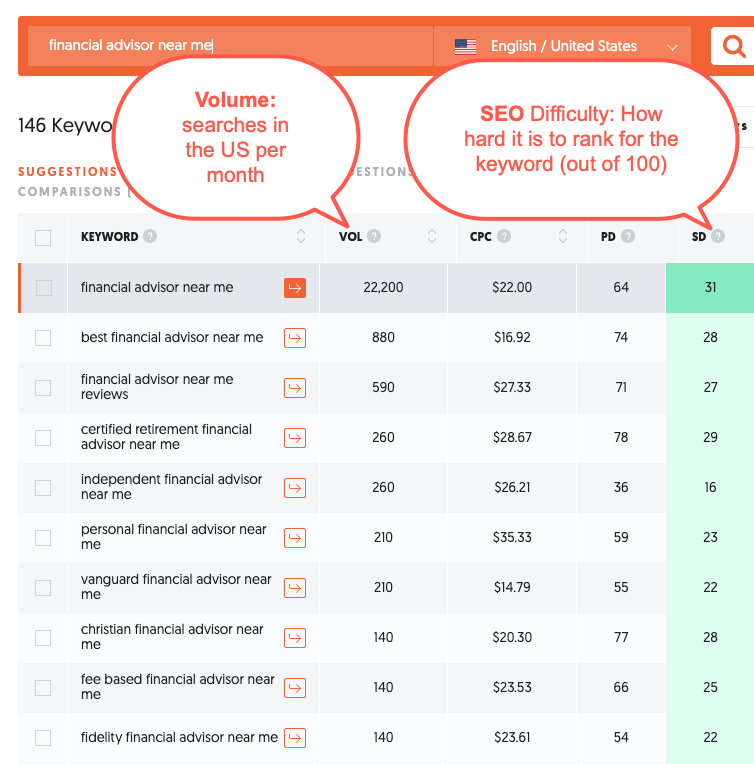
Once the appropriate keywords are identified, they should be added to titles and section headlines of website content – preferably at the beginning of the titles and headlines. For example, if the target keyword is “best financial advisors,” a good title for a blog post could be “The Best Financial Advisors Have These Three Qualities in Common.”
With keywords identified and incorporated into titles and section headlines, the actual content can finally be created (or optimized, if content is already available on the website), with several best practices to keep in mind.
The trick is to incorporate as many items on the checklist below without making the content awkward or difficult for a human to read. If a choice needs to be made between optimizing for Google or a human reader, err on the side of the latter. Don’t stress about hitting all of the checklist items while writing – especially for those new to the process. Advisors can (and should) go back and optimize content once they have the first draft.
On-Page SEO Best Practices/Optimization Checklist
At this point, on-page SEO becomes a process of checking off a list of best practices. Advisors can use the list below to literally check off these best practices, or if using a WordPress site, a great plugin called Yoast SEO can be installed. This plugin keeps track of on-page efforts and indicates things that are going well, and what should be changed. This printable checklist can also be downloaded to use for on-page and site-wide optimizations.
Page-level Optimization
These are on-page optimizations to conduct on individual pages of a website:
- Include target keywords in the headline title. Target keywords are most effective when they are used at the beginning of the title.
Headlines should always be formatted with the “H1” HTML tag. H1 tags serve the dual purpose setting the font style and size of the headline text (usually the largest on the page) and telling search engines what a webpage is about.
- Include target keywords in subheadings. Subheadings are also indicated by HTML headline tags, but rather than H1, they should be formatted with H2 through H6 HTML tags. Typically, text will get smaller as the number in the tag increases. For example, H2 text will be larger than H3 text. In addition to giving Google further indication of a page’s subject matter, subheadings do a great job of making content more readable by breaking up dense blocks of text into more digestible sections – a practice that both search engines and readers appreciate. For more on headline tags, check out this Yoast.com article about how to use headings on a site.
- Include keywords in the SEO title. The SEO title is the blue text assigned to the website link that shows up as the first line of a search result (the font color turns purple once it gets clicked). Here again, target keywords should be placed at the beginning.
SEO titles should also be kept under 60 characters, so they don’t get cut off on the results page.
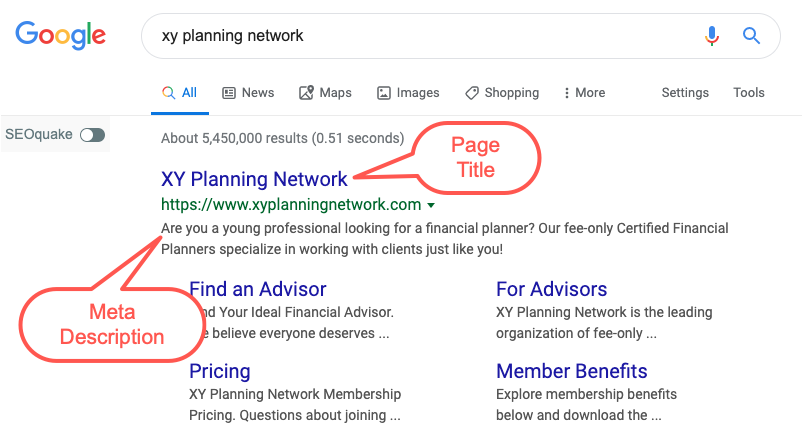
- Include keywords in the first paragraph of introduction sections. Make it clear right from the start what the page is about by using target keywords in the first paragraph.
- Include keywords in the slug. The “slug” is the name used to identify the page address. For example: www.website.com/this-is-the-slug. Keywords should be used here as well. It makes it clear – even out of context – what the page is about.
- Use an appropriate keyword frequency. The keyword-to-text ratio is referred to as “keyword density.” And while target keywords should be mentioned often enough in the text body to reinforce what a page is about, care should be used not to overdo it.
Because if the keywords being used happen to account for more than three percent of the text on a page, it may look like low-quality, “spammy” content to search engines, and the site content can get penalized for “keyword stuffing.” On the other hand, if the keyword density is too low, search engines will have trouble figuring out what the page is about.
WordPress site users who use the Yoast SEO plugin can measure keyword density and several other items on this list. Other users who do not use WordPress can use a keyword density checker like the one offered through the SEO Review Tools website.
- Don’t target the same keywords in different areas of a site, otherwise, “keyword cannibalization” can occur, which happens when two pages on the same site try to rank for the same keyword. The reason that’s problematic is that it dilutes the number of clicks each page gets when it appears in search results, and the clicks themselves are an important ranking factor.
- Use images with ALT tags. Like subheadings, images serve a dual purpose. First, they improve readability by breaking up text and providing visual interest. They also present another opportunity to tell search engines what a page is about by using the target keyword in an HTML “ALT-tag” that can be associated with each image.
An ALT tag is simply text that is assigned to an image. That text can be a brief description or comment about the image, which is how a search engine can recognize what graphic images on the website represent when it is assessing the site content. Accordingly, including target keywords in ALT-tag text will increase the likelihood that search engines will correlate website content with the target search keywords.
Beyond the SEO benefits, these tags are used to indicate the subject matter of an image in the event that it can’t be displayed, and to assist visually impaired users who employ screen readers to browse the web.
- Create a compelling meta description. The meta description is the text that appears below the link in the search result, providing a brief overview of the page. It should be long enough to provide a good overview of the website (at least 120 characters is ideal), but no more than 156 characters to avoid being truncated.
Beyond the page title, the meta description offers the best shot to convince the searcher to click on a link. Since the searcher just entered the target keyword as their search term, the keywords should be included early in the meta description to make it easy for the searcher to make the connection.
Content management systems like WordPress or TwentyOverTen allow custom meta descriptions to be entered using a form field.
- Include relevant outbound links to provide search engine with context to the site. Links to other websites that support points on a website page or provide further information can give search engines more context on what a website is about.
For example, this post is about SEO, and all the outbound links (i.e., the links included in this post that bring the reader to outside websites) herein have something to do with SEO. So when a search engine analyzes the links embedded in this post, it will recognize that “SEO” is an often-referenced topic, increasing the likelihood that the site will appear as a result for someone who searches for topics related to “SEO”.
- Include relevant internal links to provide additional context, and to help develop topic clusters. If a page links to at least one other related page on its own site, Google gets even more contextual clues about the page content and the site as a whole.
This also helps to develop “topic clusters” on the site. Topic clusters help search engines determine the depth of the content related to keywords on the site. The “deeper” the content related to a subject, the better.
- Article length should be at least 300 words per page. Each page should have at least 300 words, because it’s difficult to provide much value to readers in fewer words. Additionally, it’s generally more difficult for search engines to derive enough contextual information to understand exactly what the page is about when there is less than 300 words on the page.
And that’s the on-page checklist. It may look like a lot, but as website owners get more familiar with what it contains, they will find that writing most of the items into posts on the first pass becomes easier and increasingly natural over time.
Site-wide Optimization
In addition to optimizing individual pages to more closely align them with target keywords, two site-wide requirements should be assessed as well. These include:
- Mobile-friendliness: make sure that every page on the site is usable on mobile devices. Sending users to hard-to-use sites doesn't reflect well with Google, and the site will be penalized if it doesn’t measure up. Google’s mobile-friendliness tool will show how mobile-friendly a site is.
- Speed: slow loading sites are a pain, and Google only wants to send users to sites that will give them what they need, when they need it. Use Google’s PageSpeed Insights tool for this one.
These factors are important because smartphones are now very commonly used to access web content, and if a website is difficult to see or takes too long to load, chances are that a potential visitors will simply skip the slow-loading site and move on to the next search engine result that belongs to that site’s competitor.
For sites that don’t score well on either mobile-friendliness or speed, a good web developer can troubleshoot issues that can improve scores in each area. Alternatively, a website consultant can help with the process of improving these attributes.
Once the site itself is optimized using these on-page and site-wide SEO tips, it’s time to spread the word. Enter: off-page optimization.
Off-Page SEO: Networking With Other Websites
Off-page is all about link-building, which is essentially the practice of getting other sites to link to yours. It is important for a website to have links included by other unrelated websites because Google sees these links as ‘votes’ for the quality of the linked site’s content. Search engines derive subject matter context from the anchor text (the clickable words usually highlighted in blue, which turn purple once clicked) assigned to a link on another website; when the user clicks on that anchor text, they are brought to the linked website.
That said, all links are not created equal. Part of the Google PageRank algorithm involves measuring the overall quality of a page or site, which is best expressed using a metric called “page authority” (which assesses a single web page) or “domain authority” (which examines a set of pages that make up an entire site). Links from other sites that rank highly in page or domain authority are more valuable to the site being linked to than those for sites and pages with lower authority.
While MOZ, the company that developed the metric, provides tools for measuring a domain or page’s authority, it’s pretty easy to identify high-authority sites. They tend to be very deep in content and published by brands or individuals that are highly regarded in a given industry or on a particular subject (like the one you’re reading now).
In general, the way to attract sites with high-ranking authority to link to a site is to publish high-quality content that is valuable to the site’s target market. By doing so, people will want to link to it and share it. But the most powerful link building doesn’t happen on its own. It requires reaching out and networking with thought leaders and influencers in your field, and giving them a reason to link to your site.
But link-building efforts don’t necessarily need to involve chasing whales. A good place to begin is with local websites, and the CPAs, attorneys, and other allied professionals that financial advisors exchange leads with. If shooting them a call or email asking for a link feels somewhat awkward, consider adding a “resources” or “partners” page to your site containing links to their sites, and then contact them to ask permission to add their link to your site (or let them know that you’ve already included them). If they have a similar page, it’s likely they’ll be willing to return the favor. If they don’t have one, it just may turn them on to the idea.
Another high-value tactic is to offer to create guest posts on authoritative sites. What’s a guest post? You’re reading one right now. I provide this high-authority site with high-quality, useful content, and in return, I get inbound links and exposure to my target audience. #winning 🙂
Just as links from high authority sites can boost rankings, links from sites that Google sees as very low quality, or ‘spammy’ can actually hurt. The best way to avoid this is to steer clear of SEO vendors who send unsolicited emails or robocalls promising first-page rankings and/or lots of backlinks. If they’re using questionable tactics to pitch a site, they’re likely to be using questionable SEO tactics.
Unique Local SEO Strategies
The information provided above is mostly the same whether the target is an international, national, or local audience. But if the focus is local – as it is for many advisory firms – there are other, very important, SEO activities to carry out.
Why local? Because most firms draw their client base from their immediate area – and that’s a good thing because it’s much easier to rank well against local competitors than every firm in the country.
There are, however, a few situations that call for a national focus, including niche or specialty firms that want or need to reach an audience beyond the confines of their immediate area, those with a truly national presence (e.g. United Capital, Edward Jones, Ameriprise, etc.), and advisors based in less-populous areas. If you’re one of those, skip this section. If you’re not, read on for your local search playbook.
On-Page Location Modifiers
In addition to targeting the more general key phrases described in the last section, advisors who want to target locally should optimize for a specific geographic focus. This means adding location modifiers to any keywords that can be localized. For example, “financial advisor” becomes “financial advisor in Frisco, TX.”
Not every search term that’s targeted needs to have a geographic modifier. There isn’t really an ideal ratio of location-based to non-location based content to target. Just use geographic modifiers where they make sense – and there are only so many ways that can be done, so don’t force it.
If Google has clear indications of where a business is located in relation to the searcher’s location, it will take that into account, even when the search query isn’t location-based.
Next, Google should be able to determine exactly where the website’s business is located. This is accomplished by ensuring that the business Name, Address(es), and Phone number (“NAP”) are on every page of the site – usually in the footer (bottom section) of each page. This is one time when it’s fine to use the same keywords on every page. Search engines can recognize NAP and expect to see it throughout the site.
If there are multiple offices associated with a business, it’s a good idea to have a separate “Locations” page for each of the offices and to include as much relevant content as possible. Beyond NAP, a Google Map image can be embedded and directions to the office location from major highways can be provided. Remember: Google likes pages with over 300 words.
Off-Page Directory Listings
The off-site part of local SEO is all about having complete, consistent listings on the many local directory websites on the Internet – and the first one advisors should focus on is Google My Business.
If you have yet to claim and complete your business listing there, do it now. Here’s why:
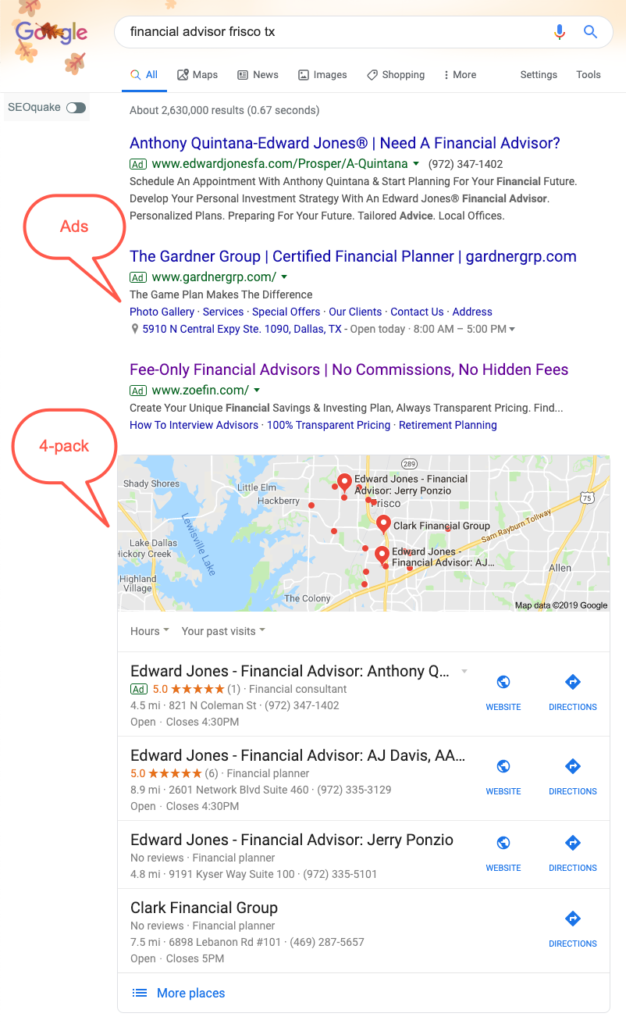
The image above shows the results of a search for the term “financial advisor Frisco TX.” The top three results are paid search ads (and while paid search is something that can definitely be beneficial for advisors, there are many factors that should be considered to use them effectively).
These results look different from those of non-local searches, and that’s because of the “4-pack” that shows up for local queries. The 4-pack shown here is the boxed area that includes a map image with businesses in the area ‘pinned’ on the map, and the details (including quick links to the business website and map directions) for the top four businesses provided immediately below the map image.
It goes without saying that the aim is to be included in one of those top spots and having on-site NAP and a profile on Google My Business squared away are the first steps in that direction.
The second step is submitting complete information about the website’s business to the many local directory sites on the web. Some directories, like Yelp, Foursquare, MapQuest, and YP.com, are very well-known services, but there are up to sixty others that many people have probably never come across, that are helpful to be listed on.
In addition to being a source of website traffic, Google, other search engines, and even vehicle navigation systems use business directories as sources of information – and if an advisor’s business is missing or inconsistent across any (or all) of the sites, it’s going to hurt the advisor’s ability to make that four-pack.
Submitting to and managing these listings is time-consuming and labor-intensive; it is not something to undertake manually because there are just too many of them. Fortunately, there are inexpensive services that gather the appropriate information and that will submit it to all relevant directory sites. They will also monitor the listings to ensure they remain consistent, as these directories can change frequently due to a variety of factors.
But for those who aren’t ready for sourcing out the responsibility to others and who prefer to manage their listings on their own, the essential sites to focus on are Google My Business, Facebook Business pages, Yelp, and at least one of the many Yellow Pages sites (e.g., YP.com, etc.).
In summary, advisors can use SEO strategies by making their websites search-friendly, and by getting search engines to notice (and trust) their websites.
Some on-page SEO tasks that can help improve the searchability of an existing website include:
- Identifying high-frequency, low competition keywords and optimizing website pages for those keywords – these keywords can be found by entering a site’s address into Ubersuggest, which will return keyword suggestions along with search volume and competition/search difficulty statistics;
- Posting new keyword-optimized content every week; which has shown to be the “sweet spot” between posting frequency and improved rankings. While this can be done less frequently, it will take longer to realize gains, and payoff per-post diminishes for posting more often;
- Including NAP information on every page, and individual pages for each location; and
- Ensuring that the site loads quickly and looks good on mobile devices.
Some off-page tasks that will increase the visibility of a site to search engines include:
- Asking trusted contacts in related fields to include a link to your website on theirs to increase inbound traffic;
- Setting up a Google My Business Page; and
- Submitting information to local directories.
By doing these things – or at least some of them – advisors will likely notice a marked improvement in traffic to their websites, not to mention that they’ll be ahead of the vast majority of their competitors in leveraging SEO strategies.
And as pointed out earlier, the financial services industry has been very slow to adopt these practices, so now is the ideal time for financial advisors to get in the game, establish a presence, and reap the rewards!


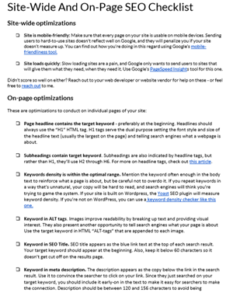



Great article! However, after really diving into the weeds at this for a bit I am begging to wonder if doing a simple website and paying for adds is a better strategy for a number of firms. Moz just did a study on local pack rankings and it seems the space packed with big brand name going for space and the CTR drops off quickly. The amount of time and effort to get a site to rank with content in many cases to rank in the local pack is beyond most firms time and budget. We have done a great deal of work on site SEO at https://www.ballplanning.com but what finally really moved the needle was off site SEO. So, my theory is starting to be for most firms to have a nice website and either create a ton of high quality content to rank, or simply pay for placement.
https://moz.com/blog/moz-local-wealth-management
Great article with some great insights.
Wow. I hope this article received more reads than the comments might suggest. I’m printing this to reference regularly. Thanks Lee!
This article is a great starting point for advisors to understand the importance and basics of SEO. In addition to the basics, advisors need to go a step further and send signals to both Google and humans that they are credible and trustworthy. This can be accomplished by linking your bio page on your site to your professional association and designation profiles on sites like NAPFA, XYPN, FPA, CFP, and others. Link to YOUR profile…not to the organization’s homepage. This helps visitors discover more information about you and helps search engines connect the dots between consistent information that demonstrates credibility. Be sure all of your online profiles are complete and consistent! Allan Slider, founder of FeeOnlyNetwork.com (exclusively for members of NAPFA, XYPN, Garrett Planning Network, and Alliance of Comprehensive Planners)
Great advice, Allan!
SEO article
As a financial advisor myself, I can vouch for the effectiveness of these SEO strategies. Investing time and effort into keyword research, creating quality content, and optimizing your website can significantly boost your online presence and attract the right clients. I had start blogging on Devolocity i need more SEO strategies.